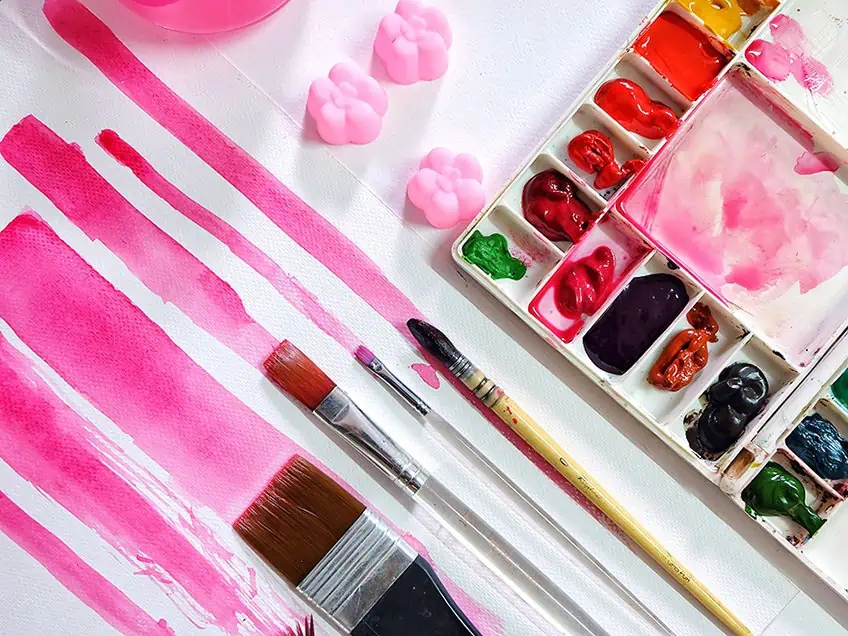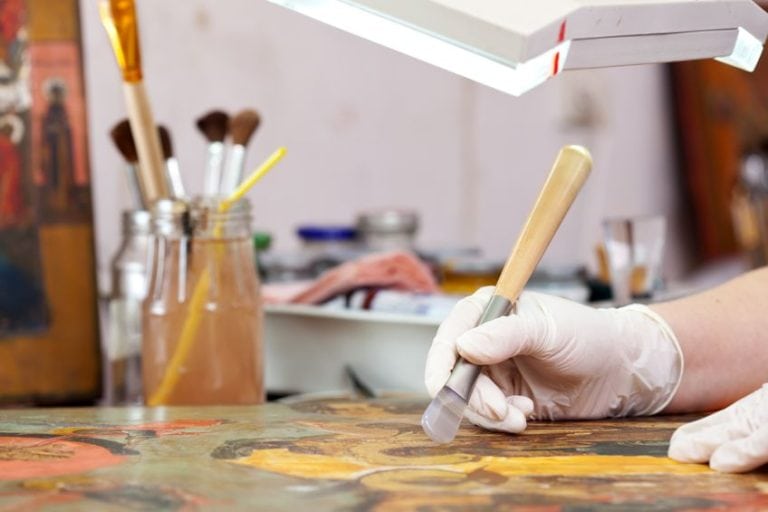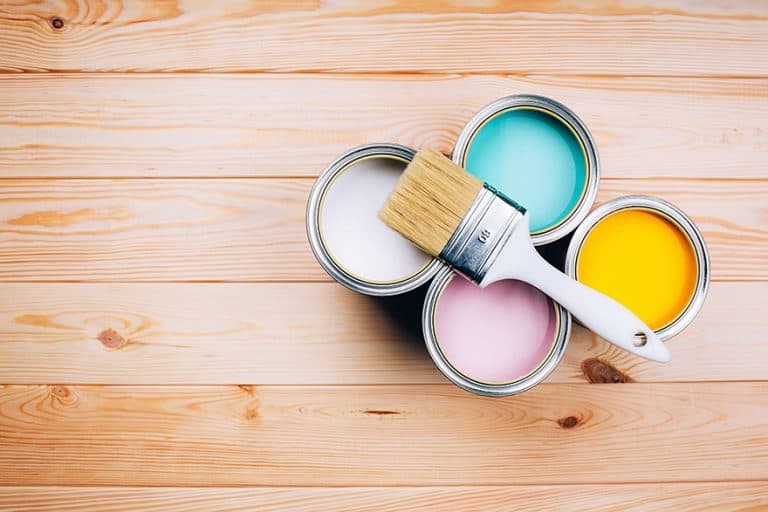Best Watercolor Brushes – Ultimate Guide for Perfect Results
This post may contain affiliate links. We may earn a small commission from purchases made through them, at no additional cost to you.
To truly embrace the beauty that comes with watercolor painting, you need the correct tools to turn your dreams into a reality. Watercolor paint brushes should be the first thing on your list. Now, when it comes to looking for the best watercolor brushes to bring your creations to life, there are a lot of different things that you will need to consider. In addition to the obvious cost implication, you will also need to decide on a shape, size, and hair type. We will be discussing all of this in-depth so that you can make an informed decision when it comes to buying watercolor paint brushes.
Table of Contents
- 1 Conclusion of the Best Watercolor Brushes
- 2 Types of Watercolor Brushes
- 3 Choosing the Correct Brush Hair
- 4 Choosing the Right Shape
- 5 What Size Watercolor Brushes Do I Need?
- 6 Understanding the Parts of a Water Paint Brush
- 7 Looking After Your Watercolor Brushes
- 8 Use Your Brush for the Correct Purpose
- 9 Frequently Asked Questions
Conclusion of the Best Watercolor Brushes
If you don’t have to the time to read our in-depth article about the best watercolor brushes, here are our top picks when it comes to watercolor painting.
| Category | Product Image | Name |
| Most Versatile | LIQUITEX Professional Paint Fine Marker Set, 6-Pieces | |
| Best Professional | AIT Art Premium Detail Brush Set | |
| Best Wash Brush |
| PATELAI 3 Pieces Flat Hake Brushes |
Types of Watercolor Brushes
As with any form of painting, you need to have the correct art supplies on hand before putting paint on canvas. One of the most obvious tools being the mighty water paint brush. Choosing the best watercolor brushes to meet your needs all boils down to your personal preference. Things you will need to consider include your technique, budget, and how different brushes feel while painting. To assist you in making a decision, we will start by looking at the first thing you will need to look at, the brush hair.

Watercolor paint brushes differ from other brush types in that they have long, absorbent hairs that can be natural or synthetic. Their handles are shorter to give artists more control, allowing them to work more closely to the surface while creating delicate designs and details.
Choosing the Correct Brush Hair
Before we dive in, it is worth noting that there are synthetic and natural brushes available. This means that there will be significant price differences to consider as well as the properties that each type of hair offers. The next thing you will need to look at when it comes to buying a water paint brush is the resilience of the brush as well as its performance. In terms of resilience, you want the brush to last and not disintegrate after a few uses.
When we consider performance, the main thing you need to look out for is the amount of water or paint that can be held in its belly. It also needs to be able to hold a fine point and distribute the paint smoothly and evenly. The hairs need to bounce back to their original shape after use and be able to do so for as long as possible – you do not want to invest in a brush that does not last or perform.
Of course, you also need to determine what you are willing to spend, as this will narrow down your search area significantly. It is also worth deciding if it is really worth buying a watercolor brush set or simply a few brushes to get started.
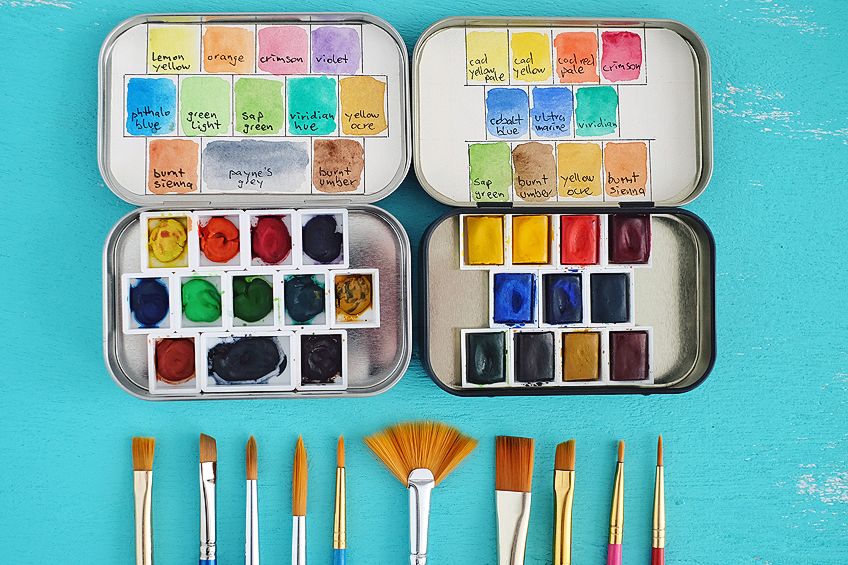
Sable
As the name implies, this brush makes use of sable hair. Sable brushes are by far the best watercolor brushes, although they are the more expensive option. The hair is taken from a sable’s tail. The most commonly used hair comes from a species of marten found in northern Asia, although the best hair comes from the Kolinsky sable which is actually a weasel found in Siberia. When carefully looked after, these brushes can keep their texture and shape for years, making them a worthwhile investment.
Kolinsky sable brushes are mostly used by professional artists and can be used in a wide range of brush shapes, although round brushes are the most popular as they are best able to maintain their shape and hold a point. For a more budget-friendly sable option, look for labels that include pure sable or red sable.
Squirrel, Goat, and Ox
These hairs do not hold a pint well and should not be used on round brushes. They are best suited for wash techniques. Goat and squirrel hair brushes are ideal for wash and mop brushes, while ox hair is the better option for square or flat brushes due to the strong, coarse nature of the hair. There is a variety of ox hair brush called sabeline brushes. These brushes have been dyed to resemble the red sable brushes.
Hog
When you are considering a large wash brush, hog hair brushes are recommended. They are able to hold and distribute quite a bit of paint. These brushes are durable and come with a reasonable price tag. So, if you are looking for a durable brush that can handle any challenge you through its way while delivering a ton of watercolor paint, look no further.
Camel
We are including this option only to warn you not to use anything labeled as camel hair. The hair on this brush does not come from a camel and is instead a blend of inferior quality hair and should be avoided at all costs.
Synthetic
These brushes have fibers or hairs that are made using polyester or nylon. They are able to replicate the performance and structure of natural hair brushes at a fraction of the cost. The quality will vary from brand to brand, but in most cases, they are able to hold a point. The downside is that they are unable to hold as much paint as the natural variety, cannot distribute the paint as evenly, and do not last as long. When it comes to round brushes that hold point, they are a great alternative if you cannot afford sable brushes.

Choosing the Right Shape
There are so many different shapes that watercolor paintbrushes come in and each of them is best suited to different painting techniques. Think of each brush shape as a tool for a specific task and will depend on your personal preference. No two painters have the same style, so we recommend trying a few different options to get a feel of what you are working with and take it from there.
While you can definitely look at buying a watercolor brush set, this can be expensive. Try to buy a few different brushes that are versatile when it comes to painting to determine which types of watercolor brushes you need.

Versatile Brushes
When it comes to versatility, round brushes are the way to go. The shape of the brush is perfect for intricate details and fine lines but can also be used for washes and broader strokes. We recommend looking for a Kolinsky sable brush if you have the budget available. Otherwise, look for a combination of a synthetic brush.
While flat brushes are not as versatile as round brushes, they are great for creating strong lines and strokes as well as washes. High-quality hair is not as important when it comes to flat brushes, but you will still want to look for an option that is durable and will last. You can opt for a sable hair variety or look for more cost-effective options depending on your needs.
Most Versatile Brush Set: ALERIE Paintbrush Set
Not only are these brushes versatile, but they are also a great introduction to the world of watercolor if you are starting out on your journey. Alerie’s set of watercolor paintbrushes include 9 different brushes and are comfortable to use.
- Set includes 9 nyoon paint brushes, Brushes come in different sizes:#0,#2,#4,#6,#8,#10,#12,#14, #16.
- With layers painted birch wood handles in special painting color, straight and persistent foaming,
- Good elasticity, absorb a good amount of, no stay or spread while paining
PROS
- Different brush sizes
- Versatile
- Durable
- Ergonomic handles
- Non-shed synthetic bristles
CONS
- Some of the bristles are too long
Detailed Work
Detailed work requires a brush that is able to hold a pint as well as its shape. Round brushes are suitable for this purpose, however, if you are looking to complete a lot of detailed work then we recommend looking into buying a rigger or spotter brush.
Spotter, or retouching, brushes are very similar to small round brushes, however, their bristles are shorter and will give you more control. Rigger brushes on the other hand are essentially round brushes that have longer bristles. As result, they are able to hold a lot of paint while providing a fine point. We recommend investing in high-quality brushes as they will work out cheaper in the long run as they are durable.
Best Professional Watercolor Brushes for Detailed Work: AIT ART Brushes
These brushes have been handcrafted in the USA to ensure superior quality. This set by AIT Art contains everything you need to bring your detailed works of art to life. The red sable bristles do not shed, and the silver nickel ferrules will not rust, which means this set will last for years.
- USA made round detail brush set; enjoy professional results with oil, acrylic, and watercolor
- Pure Kolinsky Russian Red Sable; excellent paint holding capacity with smooth flow and ultimate snap and spring
- Five different sizes that you need most: #10/0, #3/0, #0, #2, #4; easily craft the finest details
PROS
- Superior craftmanship
- Versatile
- Comes with a one-year guarantee
- Made with red sable hair
CONS
- Expensive
Wash Work
When it comes to wash work, you will want to invest in a wash brush. They are essentially wider than flat brushes. You can also look at hake brushes which perform the same function, while oval and mop brushes are ideal for applying a ton of paint or blending colors.
Best Wash Brush Set: PATELAI
Patelai has a great three-piece flat hake brush set to make wash work a breeze. These brushes have been handcrafted using sheep’s hair and are lightweight and durable to make them even easier to use.
- 3 pieces different size long handle wool brushes, ideal for applying color to large areas
- Made of quality sheep hair with long, natural wood handle and sturdy threaded copper wire
- Iincluding 9 x 1 inches, 9 x 2 inches, 9 x 3 inches (L x W), ideal for blending watercolors
PROS
- Durable
- Smooth brushstrokes
- Can be used with multiple mediums
- Easy to store
CONS
- Bristles can become dislodged
What Size Watercolor Brushes Do I Need?
This is a slightly more straightforward process than the other elements that go into choosing the best watercolor brushes for beginners. If you want to create washes or bold strokes, look for a large brush. Mid-sized brushes are incredibly versatile while small brushes work best for detailed work. We know that buying a lot of brushes can become an expensive exercise, so you will need to make some tough decisions.
Brush sizes range from 0000 to 50 and can differ amongst brands, but do not worry, you will not need to use all of them. Our rule of thumb is to have a selection of round brushes with a wash brush or flat brush. Your selection will depend on what you are planning to do with them. So, to answer the question “what size watercolor brushes do I need?”, you need to think of what you will be painting and the types of watercolor brushes that will best meet this need.

The best watercolor brushes for beginners have been selected based on their versatility. We recommend round brushes, more specifically, a small size 3 brush, a medium-size 6 brush, and a large size 12 brush. This set will be more than enough when you are first starting your watercolor painting journey.
When choosing a round brush, the first thing to look for is its ability to hold its shape as well as a fine point. Once again, sable brushes are the best option, and if you can buy a Kolinsky sable brush even better as it has the performance and durability you need to succeed. If sable is too expensive, look for a synthetic brush or sable-synthetic blend. They will offer impressive performance, although they are not as durable.
Understanding the Parts of a Water Paint Brush
We have already discussed the most important and notable part of the water paint brush, the bristles as well as the different shapes and sizes. However, if you have seen a paintbrush – which we are sure that you have, you will know that there is more to it than the bristles. We will be taking a look at the rest of the brush, as well as what you need to know about each section.

The Handle
This is the second most important thing to consider when choosing your brushes. Not only should it be durable, but it also needs to be ergonomic and feel comfortable in your hand. This is something that you will need to test as not all brushes offer the same level of comfort to different artists. The size and shape of your hand as well as your technique will affect the feel of the brush. We recommend avoiding plastic handles at all costs and look at brushes with hardwood handles.
Ferrule
The meta part of the brush, the part that connects everything, is called the ferrule. The metal part secures the bristles to the brush; however, it also provides a barrier between the handle and bristles to keep out water. Any potential gap in the ferrule can damage the handle and result in the wood rotting.
Heel
This is where the hairs or bristles are clamped in. You do not want to see blobs of glue as it indicates a poorly crafted brush. all of the hair needs to be neatly packed and sleek, with no potential fly-aways. The different types of hair will also come into play here and will need to be secured accordingly as you only see half of the hair, the rest is firmly secured in the ferrule. This needs to be double-checked and any signs of glue are an indication of poor quality.
Belly
The belly holds the water and paint, and the amount of liquid that it can hold will determine your stroke as well as how long you will be able to paint for. The way in which it distributes the liquid wll also need to be considered as the amount it distributes will determine the outcome of your stroke, will it slowly release liquid or release everything at once?
Tip
This is the end of the bristles that you actually use to paint. The type of tip you choose will be determined by what you are looking to paint. For example, a fine tip works well for detailed pieces while flat brushes work well with paint washes. Any stray or bent hairs at the tip will ruin your brush as it affects the integrity as well as its ability to draw fine lines and details.

Looking After Your Watercolor Brushes
Considering the fact that watercolor brushes are quite an investment, finding ways to look after them to ensure that they last long are important. Luckily, these paint brushes are low maintenance and with a little bit of effort, they can last a few years. On the flip side, neglecting your brushes will result in them breaking within a few uses which are not ideal. To help you preserve your wat paintbrushes, we have compiled some quick care tips.
Use Your Brush for the Correct Purpose
Watercolor brushes were made to pull pigment across a canvas or page, and in some instances, lightly mix paint. Some can be used for other techniques such as stippling or scrubbing, however, these brushes respond best when used solely for watercolor painting and not using any other mediums.
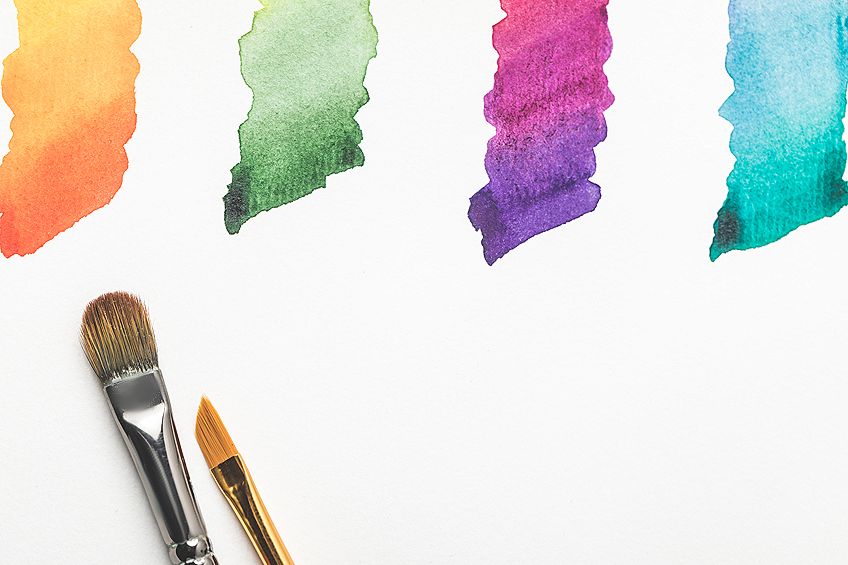
Prewet the Pigment
To prevent the tips of your watercolor brushes from fraying or snapping hairs, we recommend wetting your paint beforehand. This will soften the surface and prevent any unwanted bristle that may arise when the paint is hard. Prewetting the paint also adds to the vibrancy of the color, so keep a spray bottle or mister on hand.
How to Use the Brush
The tip of your brush is not a shovel, so to protect it, do not use it to dab or constantly push down when using it on watercolor paper or watercolor blocks. This is even more of a problem when using synthetic brushes as they lack the snap and durability that natural hair brushes offer, instead, they will fray and split. Carefully loading your brush will provide smoother results and stunning completed works of art.
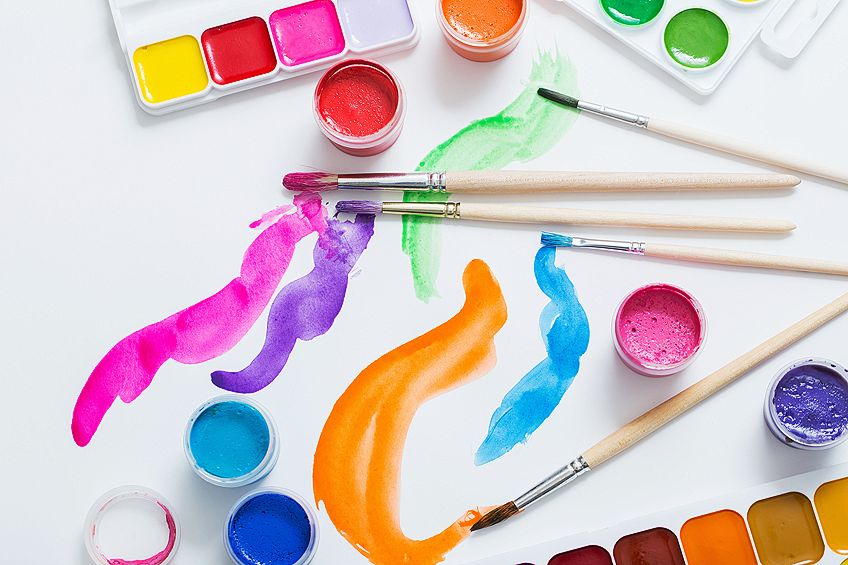
Look After the Ferrule
While getting the tip of the brush wet is a given, you need to ensure that the ferrule is watertight to prevent the clamped hairs and handle from being damaged by water. Once the water has entered this space, it is difficult to clean, and you will not be able to save your brushes. Try to only wet the tip and avoid submerging the brush in water.
Dry in a Flat Position
Many watercolor paintbrush handles are wooden and will expand when exposed to water, so storing your brushes with the tip in the air is not advisable. You also cannot store it with the tip facing down as it will damage the bristles. So, the only logical way to store it is lying on a flat surface. This will help preserve your brush by preventing damage to the bristles, ferrules, and handle.

Clean Your Brushes Properly
When painting with watercolors, you will find that your brushes need to be cleaned constantly to ensure the color and pigment are what you want them to be. When you are done using your paintbrushes, ensure that all traces of pigment have been cleaned off before storing them. Gentle brush cleaner should be used every few weeks to give your brushes a deep clean and quick condition.
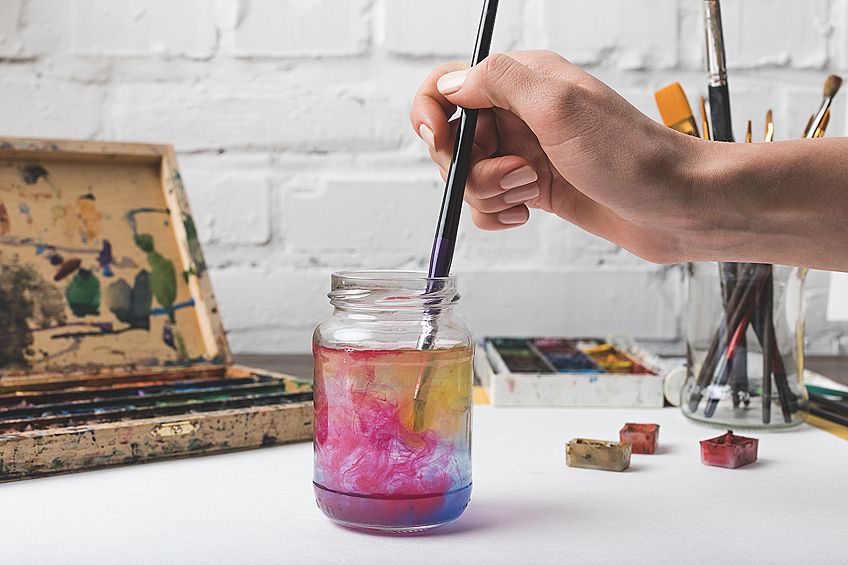
Take it Easy When Cleaning
While you should be cleaning your brushes, be careful when doing so. Hot water, solvents, and soaps are not always good for the brush and can end up doing more harm than good. All you need is a clean glass of water to swish it around in and a towel to blot it on. Do not worry too much about stained bristles, unless they are changing the color of your pigment, they should not be a problem.
Maintain the Tip
Once you have finished cleaning your brush, it is important that you reshape the brush and repoint the tip to keep it in peak condition. Failure to do so can result in the bristles splitting into weird directions, leaving it unusable. If the bristles do dry in a weird direction, rewet the brush and try reshaping it.
Do Not Soak Your Brushes
As already mentioned, only wet the tip of your brush, and do not submerge it in water. The last thing you want to do is damage the bristles, have water creep into the ferrules, and have the handle damaged in the process. This is one of the easiest ways to destroy a watercolor paintbrush.
Frequently Asked Questions
What Makes a Watercolor Brush Different to Other Kinds of Paintbrushes?
Watercolor brushes were designed to drag pigment across the surface, and as such, have longer bristles to do so. The handle is also shorter to allow for more control while painting. You can, of course, use this brush for other mediums, however, once you do so you will not be able to use it for water painting again.
What Can I Use When Cleaning My Brushes?
Stay away from soaps, solvents, and other harsh chemicals as they will damage the bristles. Clean water is all you need to keep your brush clean, but do not keep it submerged. You can also use a gentle brush cleaner every few weeks to give your set a deep clean and condition.
Which Brushes Are the Most Versatile?
Without a doubt, round brushes are by far the most versatile. Depending on their size, round brushes can be used for fine detail as well as wash work. They are great for beginners and depending on the type of bristle you choose, can be incredibly durable.
What Can I Do About Stray Hairs?
If the bristles have dried and strange directions, you can try to salvage the brush by wetting the bristles and reshaping them the way that they should be. Do not cut the bristles, this will ruin your brush so unless you are looking to buy a new one regardless, do not do it.
Matthew Matthysen is a multidisciplinary artist. He completed his fine art degree, majoring in History of Art and Contemporary Drawing Practice at the University of Witwatersrand, South Africa. Before joining acrylgiessen In 2020, Matthew worked part-time as an art teacher at Reddford Blue Hills High school. Matthew creates drawing and painting tutorials for acrylgiessen and captures them not only photographically and in written form. He also records the creation of his works in his own creative studio as in video format, from which later with a voiceover and a video editor also drawing tutorials for the Youtube channel of acrylgiessen are created.
Learn more about Matthew Matthysen and about acrylgiessen.
